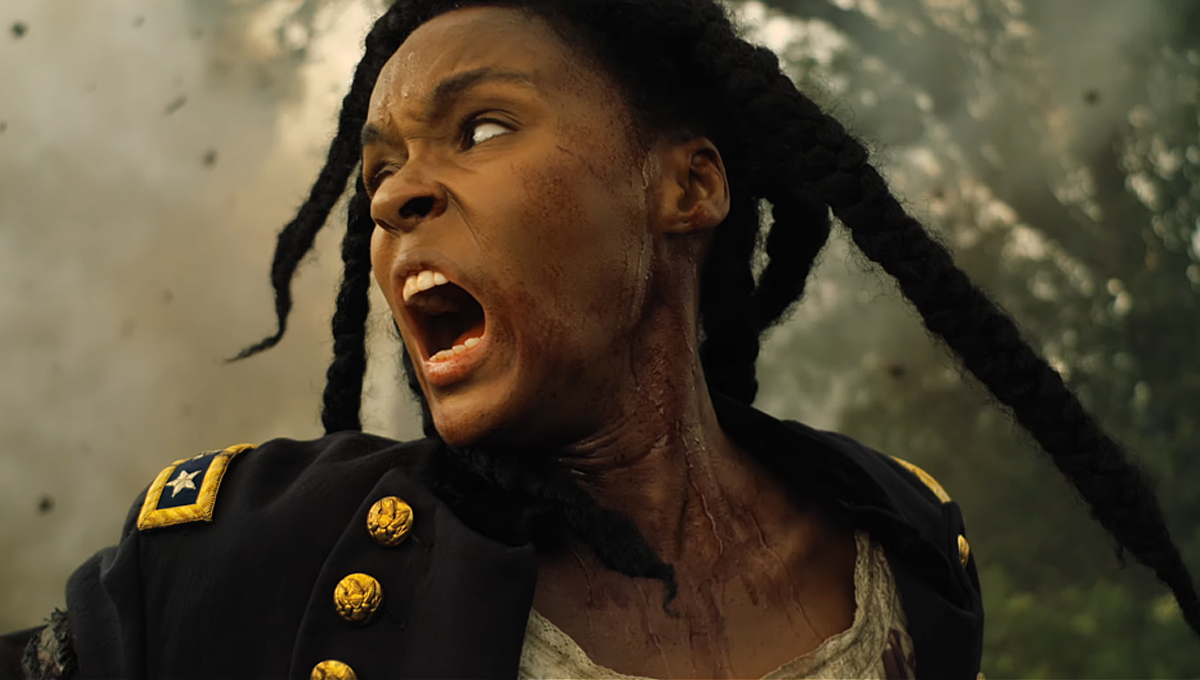Antebellum is the debut feature-length film by writer/director duo Gerard Bush and Christopher Renz. In the film, they aim to explore what happens when the past, present, and future collide in a time where activism against injustice is prevalent. And it comes from one of the producers of the successful thriller, Get Out, which seems to be a regular announcement made among horror and thriller films these days. When you see those words pop up on the screen, expect a movie with a strong social message. It’s like woke cinema is its own genre now.
But a film that focuses on beating its themes to death is rarely entertaining, and such is the case with Antebellum, an aimless movie with no purpose other than shock value. What’s the purpose of displaying such overt brutality without reprieve? Does the film need to revel in disturbing imagery to tell us something we already know? Hollywood can produce films that speak to race relations in America without all the violence, but here we are.
Antebellum opens with a single-take shot that gives the audience a tour of a plantation. Slaves are working, masters yell at the enslaved, and then we meet Eden (Janelle Monáe), regaining consciousness as she’s pulled off a horse, with no idea of where she has come from or how she got there. We see a man in shackles being held back as his lover tries to run from the plantation. There is something off about this place because the Black slaves are wearing gold chains, have septum piercings, and they’re particularly bold toward their masters and have no problem talking back.
Veronica (also Janelle Monáe) is a wife, mother, scholar and successful public speaker in the modern era. She’s gearing up to fly to Louisiana for a conference. Once she arrives, a series of coincidences tips her off to the unusual atmosphere—but she remains unaware of the sinister plot taking place out of her sight. The two sides converge when Veronica is blindsided after a celebratory night with her friends Dawn (Gabourey Sidibe) and Sarah (Lily Cowles).
Antebellum‘s trailers come off as elevated and intelligent, but it is laborious for the mind and body to experience. The mystery box plot twist is transparent from the first ten minutes of the film with its gold-adorned, emboldened slaves. The narrative is all over the place as it struggles, jumping between genres and dropping easter eggs that serve no purpose. A creepy pale child appears in an elevator next to Veronica with her doll on a noose and is never seen again. At the convention, Veronica stays in the Jefferson suite–get it? Thomas Jefferson owned slaves, and you’re next, Veronica! How dull.
Bush and Renz want to align with the Black cause desperately but can’t do that without indulging in Black suffering. Because of this, every character is an underdeveloped, scenery-chewing caricature. When Veronica speaks with a Fox News stand-in about race and liberation, the discussion plays like satire. Monáe is talented and does what she can with what she’s given, but every time Veronica opens her mouth, she spews every woke keyword you would find on Black Twitter, and it goes on and on until it’s comical. Is that what they think people sound like online?
The villains are no better. Elizabeth (Jena Malone) and Captain Jasper (Jack Huston) deliver their lines as if they went to the Yosemite Sam School for Dramatic Arts. They’re plot devices used disgusised as super evil racist villains, and nothing more. They never reveal their motivations or rationale. Sadism for sadism’s sake does not make a good villain.
The technical aspects of the film are far superior to the story. The transitions between the lives of Veronica and Eden are executed seamlessly. Each edit zones in on Monae’s face, and as her environment changes, her facial expressions stay the same. The framing of various shots gives the audience an intimate look into the hollow souls of each character. Veronica’s most beautiful moment is a slow-motion sweeping shot on a horse in the middle of a shootout.
But the highlight is the score and sound. The sound is so clear and crisp if you close your eyes, you could be in the movie hearing things happen in real-time. And their euphonious soundtrack craft by Roman GianArthur Irvin and Nate ‘Rocket’ Wonder captures the chilling tone that fits perfectly with each scene.
The intended demographic for Antebellum will walk away from this film feeling empty. Sure, the villains get their comeuppance but at what cost? Slave stories need something other than visual carnage to cross the line from trauma porn to a complete story.
Casting a talent like Janelle Monáe isn’t especially useful when she bears the unfair burden of carrying the film on her shoulders. The concept of Antebellum sounds good on paper, but it’s nothing but exploitative about a history we are already familiar with. Not every horror film with a social message can be Get Out, and they shouldn’t be striving to imitate that. But they should at least be striving to stand on their own.
